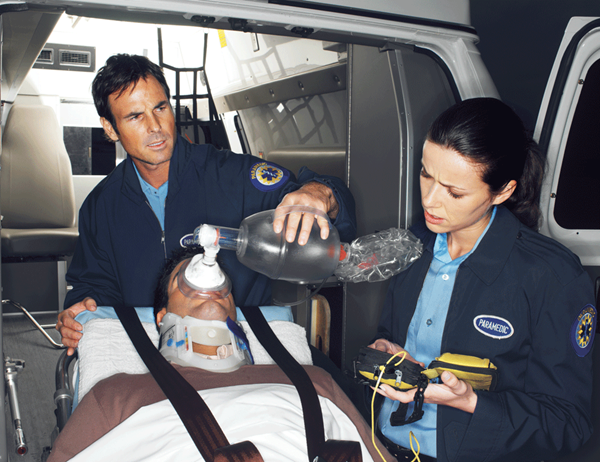The world of EMS represents a mosaic of different systems and practices that share a common goal.
If the emergency department had a mouth, it would undoubtedly be the doors that open to the ambulance bays. Spend five minutes with a triage nurse and you'll be able to appreciate the insatiable appetite that the ED has. To those who have not worked in the pre-hospital environment, the flow of these patients is often taken for granted. In reality, it is the end-point of a well-orchestrated system that functions to deliver sick patients from the environment to definitive care.
Emergency medical services, or EMS, is a branch of first responders concerned with medical treatment in the pre-hospital environment. The individuals who operate the ambulance, namely paramedics and emergency medical technicians (EMTs), vary in their scope of care depending on their level of certification and area of operation. While there are regional differences, the National Registry of EMTs certifies four levels of care.
Certification Levels
Formerly called a “certified first responder,” the emergency medical responder (EMR) is an entry-level certification in EMS that is often possessed by police and firefighters. The 40- to 60-hour course teaches CPR, basic first aid, and patient assessment. The EMT is the next step up and provides basic life support certification, including the ability to administer oxygen. Whereas the EMR cannot independently transport patients, the EMT can. Above EMT is the advanced EMT (AEMT), whose skill sets are expanded to include low-risk, high-benefit interventions, including intravenous access, cardiac monitoring, and advanced airways. Several variants of the AEMT may exist locally, including the EMT-critical care in New York. Attempts at consolidating the different certifications under the umbrella of “AEMT” are underway. Finally, the paramedic is the highest level of certification and is often given a higher level of autonomy in advanced care than lower levels of certification.
Variants of paramedic may be seen, including critical-care paramedics, rescue paramedics, and hazardous materials paramedics, whose scope of practice may be expanded under the authorization of an agency's medical director.
Critical care paramedics often engage in emergent transports between facilities, and may have the training to use ventilators, intra-aortic balloon pumps, medication pumps, and other complex equipment. Rescue medics are frequently trained as integral members of a technical rescue team and may have expanded protocols to address issues arising in austere environments. Hazardous materials paramedics may have an expanded formulary to address toxic exposures that would otherwise be rare to other paramedics. Ultimately, the care rendered by an agency is dependent on state and local protocols and medical director authorization.
The level of autonomy of EMS providers is often misunderstood by physicians, who do not understand the overarching nature of treatment protocols in the practice of pre-hospital providers. For this reason, it is always appropriate for emergency medicine physicians to familiarize themselves with the regional certification levels and treatment protocols. These are usually available from the local regional EMS council (REMSCO).
Agency Types
Emergency medicine service agencies exist in a number of different flavors, including hospital-based, fire- and police-based, volunteer, private companies, and others. The interplay of these agencies has much to do with the type of patients that they bring into the ED. In many places, private companies and hospital-based companies are more engaged in non-emergent transport of patients between health care facilities and residences, while in other communities these same agencies may dominate the 911 environment. Some fire departments endorse EMS, while others do not. Volunteer agencies, including fire departments and volunteer ambulance corps (VACs), provide a substantial amount of manpower and equipment that is often underappreciated. It is important to recognize that volunteer providers require the same training and certification as paid technicians. Once again, familiarization with the role that each of these agencies plays in the community can be helpful in understanding the EMS cilmate. For example, in New York City, the pre-hospital environment is dominated by the Fire Department of New York. In order to manage the abundance of calls that occur daily, the FDNY certifies other agencies as “911-Participating Members,” and encourages the use of the FDNY communication systems and protocols.
Physicians in EMS
The physician's role in EMS can be significant. Physicians may be involved in the training of pre-hospital personnel, especially when they are use in internal training programs for hospital systems or when they are used to provide CME units for regional EMS providers. Every EMS agency also requires a physician medical director who is responsible for guidance and oversight and who has the capacity to approve and extend protocols. Emergency department physicians may also be called on to provide on-line medical direction (“medical control”) to medics in the field who are requesting certain interventions. In these cases, the paramedics are protected by the treatment decisions made by the physician. Some systems employ physicians in first-response vehicles to assist providers with on-scene care. Physicians may also sit on a regional emergency medical advisory committee (REMAC) that helps govern the practice of pre-hospital emergency care in the region.
While many physicians express interest in riding in ambulances regularly, there is neither a consensus nor a national policy statement addressing certification, training requirements, or protection from liability for physicians wishing to work as paramedics. Frequently, these issues need to be addressed at a local level, taking into consideration insurance coverage and regional policies and procedures. It may be appropriate to contact the REMSCO or REMAC for direction.
Ultimately, the world of EMS represents a mosaic of different systems and practices that share a common goal. Emergency medicine physicians can substantially improve relations with these providers by gaining an understanding of the construct in which they work. Through this kind of communication and teamwork, we can ensure compassionate, efficacious, and longitudinal care for our patients.



